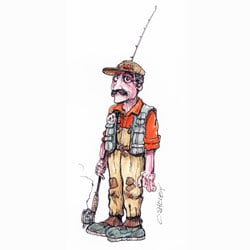They say you've never had honey until you've tried pure wild sourwood honey, a rarity now in the South. Here, Jim Mize shares his experience growing up as a beekeeper's son and why his father considered sourwood honey to be the ultimate sweet nectar.
My dad’s interest in bees began during the Great Depression when he was coming into his teenage years. He lived out in the country; times were hard and money was scarce. Whenever nature provided something for the table, he did his part in delivering it.
One of those items was wild honey. Sometimes, Dad would happen upon a bee tree, where a colony had taken residence and filled the hollows with honey. When that happened, he would come back with an ax or saw, cut down the tree and rob the honey. In those days, he had no means to hive the bees, so they moved on to another tree.
Robbing a bee tree was a lively event, considering Dad had no gear to work the bees. He would wrap a cloth around a stick, light it, and use the smoke to tame the bees before taking the honey. Still, I suspect he paid a price extracting it.

After he came back from serving in World War II, one of Dad’s hobbies was beekeeping
Word got around that he was a beekeeper, so we would sometimes get a call that someone had a swarm.
When that happened, we would drive over in the station wagon with an empty hive, and he would transfer the queen inside and let the rest of the bees follow. Usually, they would mill around outside the hive for a while, so he would come back after dark, block the entrance to the hive with a cloth for the drive home, and then set it alongside his other hives.
For many years, all of his bees were captured from wild swarms. Once he moved to the farm, he occasionally hunted bees in the woods.
We would go to the creek, find a damp, sandy shoal where bees watered and watch their flight path. When he had a general idea of where they were going, we would follow.
He had a knack for knowing where the bees were going, but if we lost their flight path and had to start over, he’d have me stand at the last sighting while he went back to the creek to watch more bees. Once was generally enough for him to locate the tree. Then, he’d go through the process of getting the bees into a hive and later move them.
His respect for bees grew over the years. If one of us referred to a wasp or hornet as a bee, he took it as an insult to his insect friends and would correct us. Only honeybees, he said, deserved to be referred to by their shorter nickname.
As a result of his beekeeping, we always had honey on the table when I was growing up
Growing up eating honey, I became something of a connoisseur. Having since traveled to many parts of North America and numerous other countries, I have sampled local honey in all these places, concluding that one honey is the best.
As you might guess, Dad had already told me that. Sourwood honey was his favorite.

When Dad managed his bees for honey, he focused on collecting sourwood honey that was as pure as it could be
His box hives consisted of stackable supers holding frames, which the bees filled with honeycomb. He managed the purity of the sourwood honey by removing the supers from the hive just as the sourwood trees began to bloom.
Most of the honey the bees produced to that point was poplar and clover, a darker and heavier honey. This would be sold locally or given to friends and family.
The empty supers would be replaced on the hive for the next few weeks while the bees worked on the sourwood blooms.
Sourwood honey is so prized by those who know the difference that some beekeepers used to keep hives on flatbed trucks and follow the pace of the blooms north through the Appalachian Mountains, thereby extending the season.
The bees would work days and the hives would be closed at night when they would relocate.
But we would optimize this short window of sourwood production and remove the honey as soon as the sourwood season ended. After that, the bees would have the rest of the summer to rebuild their food supplies to carry them over the winter.
Characteristics of pure sourwood honey
Pure sourwood honey is best described as blond
In good years, the clarity lets you see through the jar and when poured, it’s lighter and thinner than the earlier mixed honey of the season.
Dad often won ribbons at the county fair for his honey, and sometimes, he was asked if he fed his bees sugar water to make it clear. He never did.
The taste of sourwood honey is also milder, so when we smoked the hives to remove the supers, Dad was always careful not to use too much smoke; otherwise, you could taste it in the delicate flavor of the honey.
On the table, nothing complements sourwood honey so well as butter and homemade biscuits.
In my youth, I’d mix honey and butter with a table knife until blended and then smear it on a biscuit one bite at a time. I remember making this combination for breakfast or dessert after dinner.
I confess I rarely see sourwood honey that is this pure anymore. When I do, it’s generally at a roadside stand or sold from someone’s country porch. Perhaps it’s better in my memory anyway, since my biscuits are a far cry from those of my youth.

























